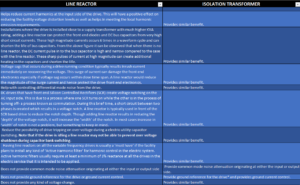Line Reactor
Line reactor as used in VFD/VSD application is an inductive component used in the line side or supply side for harmonics mitigation, voltage buffering, reduce commutation notches, reduction of differential mode noise etc.
Line Reactors are specified based on the current rating (Amps) and the inductance (mH). Current rating is based on the drive full load rating, while the inductance is expressed in milli-henry (mH) or more commonly expressed as %Z, % impedance or Uk. This %Z or %impedance convention is derived from the practice used with the transformers. %impedance of the line reactor is the percentage of the drive impedance at full load. Line reactor can be sized using this calculator.

Isolation Transformer
Isolation transformer as used in VFD/VSD application is an inductive component used in the line side or supply side for harmonics mitigation, voltage buffering, reduce commutation notches, reduction of differential mode and common mode noise etc.
Comparison of Line Reactor and Isolation Transformers
Line reactor and isolation transformer offer many similar benefits when applied on the supply side of a VFD. Both helps reduce current harmonics, protect front end diode rectifiers, provides transient voltage protection, controls differential noise, reduces voltage notching. There are some advantages and disadvantages to using both.
The table below compares line reactor with isolation transformer.
Comparison Table
| Line Reactor | Isolation Transformer |
|---|---|
| Helps reduce current harmonics at the input side of the drive. This will have a positive effect on reducing the facility voltage distortion levels as well as helps in meeting the local harmonic emission requirements. | Provides similar benefit. |
| Installations where the drive is installed close to a supply transformer with much higher KVA rating, adding a line reactor can protect the front end diodes and DC bus capacitors. | Provides similar benefit. |
| Voltage sags that occurs during a drive running condition typically results inrush current immediately on recovering the voltage. This surge of current can damage the front end electronics especially if voltage sag occurs within close time span. A line reactor would reduce the magnitude of the surge current and hence protect the drive front end electronics. | Provides similar benefit. |
| Help with controlling differential mode noise from the drive. | Provides similar benefit. |
| DC drives that have front end Silicon Controlled Rectifiers (SCR) create voltage notching on the AC input side. This is due to a process where one SCR turns on while the other is in the process of turning off- a process known as commutation. During this brief time, a short circuit between two phases is created which results in a voltage notch. A line reactor is typically used in front of the SCR based drive to reduce the notch depth. Though adding line reactor results in reducing the ‘depth’ of the voltage notch, it will increase the ‘width’ of the notch. In most cases increase in ‘width’ of notch is not a problem, but something to keep in mind. | Provides similar benefit. |
| Reduce the possibility of drive tripping on over voltage during a electric utility capacitor switching. Note that if the drive is idling a line reactor may not be able to prevent over voltage shutdown during capacitor bank switching. | Provides similar benefit. |
| Having line reactors on all the variable frequency drives is usually a ‘must have’ if the facility plans to install any kind of ‘Active Harmonic filter’ for harmonic control in the electric system. Active harmonic filters usually require at least a minimum of 3% reactance at all the drives in the electric service that it is intended to be applied. | Provides similar benefit. |
| Does not provide common mode noise attenuation originating at either the input or output side | Provide common mode noise attenuation originating at either the input or output side. |
| Does not provide ground reference for the drive or ground current control. | Provide ground reference for the drive* and provides ground current control. |
| Does not provide any kind of voltage change. | Isolation transformers permit suitable voltage change depending on the system voltage and the drive rated voltage. |
| Easy to install after commisioning. | Difficult to install after commisioning. |
| Less costly compared to isolation transformer. | Generally more costly compared to line reactor. |
| Occupies less floor space compared to isolation transformer. | Occupies more floor space compared to line reactor. |
*When secondary side of the isolation transformer neutral is grounded / earthed.
Additional reading:

